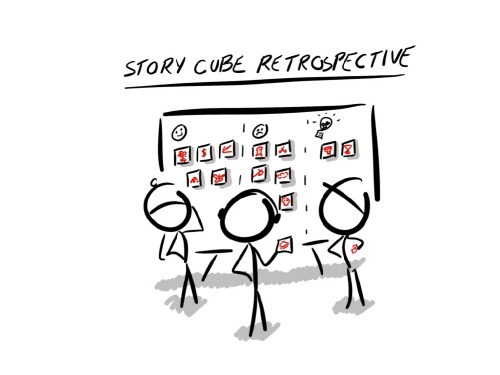Introduction
Rory's Story Cubes can be used as a metaphor to generate ideas and can be useful to try a new style of retrospective with something tactile.
Learning Objectives
- New ideas and richer customer experiences as a result of using a metaphor
Timings
- Allow 60 minutes for this workshop
Materials

Workshop Flow
Connections
Connections part of the activity are intended to enable the attendees to connect with the subject and with each other, and should have more context than “ice breakers” that would otherwise not have any relevance to the subject or context of the workshop.
| Activities
|
Description
|
| Retrospective Positioning |
Draw up on a sheet of flip chart paper or whiteboard the intention and positioning of the retrospective, i.e. what events, timeline or context are we going to hold the retrospective on.
|
| Story cube selection |
Invite the team to select 1-3 story cubes from a mixed bag and to check them out. Feel free to swap with others if they like other pictures on the cubes.
|
| Story on a Flipchart |
On a sheet of flip chart paper draw squares big enough for a post it note in a sequential order, enough for the each member of the team
|
Concepts & Concrete Practice
For a majority of the activities, they will include introducing new concepts and ideas to attendees, and also provide interactive opportunities to practice them and apply the new found knowledge.
| Activities
|
Description
|
| Roll The Cubes |
Invite the team members to roll their dice and choose a diagram that resonates strongly with them and their perspective, relative the positioning of the retro.
|
| Representation |
Next invite the team members to draw their diagram on a post-it note with a few comments, and put it on the sheet of flip chart paper, choosing a square and position in the story where they think their post it note would work well.
|
| Presentation |
Ask each of the team members to walk to the flip chart paper with the post-it notes on it and present their diagram and what it means to them. At the same time invite the other team members to write on post-it notes possible actions or improvements from the narrative that they are hearing
|
| Retro Actions |
Finally invite the team members with actions and improvements to put them on a separate sheet of flip chart paper
|
Conclusions
Conclusion activities enable the attendees to take stock of what they have learnt and how these new ideas can be applied in practice to real world projects.
| Activities
|
Description
|
| Actions |
Working through each of the actions or improvements on the second sheet of flip chart paper, facilitate a discussion on how we can get the actions realised and completed.
|
| Close |
Finish up with an action list or similar to make the ideas and improvements a reality
|
